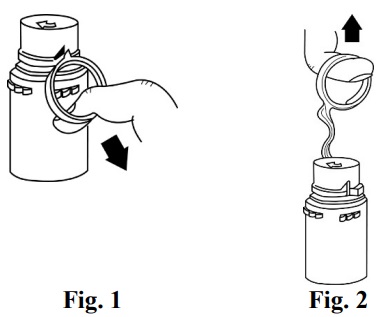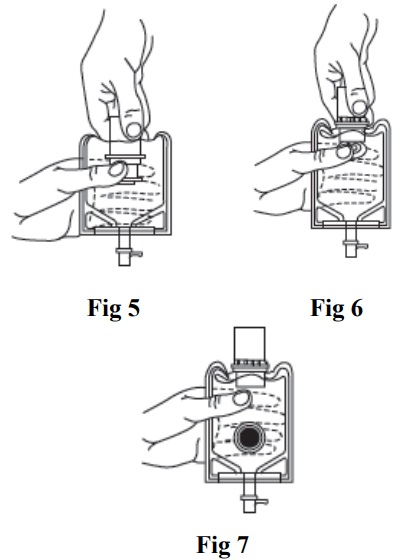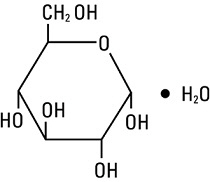Highlights
HIGHLIGHTS OF PRESCRIBING INFORMATIONThese highlights do not include all the information needed to use DEXTROSE INJECTION (5%) safely and effectively. See full prescribing information for DEXTROSE INJECTION (5%). DEXTROSE injection, for intravenous use Initial U.S. Approval: 1940 RECENT MAJOR CHANGESINDICATIONS AND USAGEDextrose Injection (5%) is indicated as a source of water and calories in adult and pediatric patients and may also be used as a diluent for reconstitution of a powder or liquid drug product. (1) DOSAGE AND ADMINISTRATIONDOSAGE FORMS AND STRENGTHSInjection:
This dextrose product is intended to be used as a diluent for the contents of an ADD-Vantage vial or a single-dose powdered drug vial with 20 mm closure using the ADD-Vantage ADDAPTORTM. (3) WARNINGS AND PRECAUTIONS
ADVERSE REACTIONSThe most common adverse reactions are hyperglycemia, hypersensitivity reactions, hyponatremia, infection (both systemic and at the injection site), vein thrombosis, phlebitis, and electrolyte imbalance. (6) To report SUSPECTED ADVERSE REACTIONS, contact Pfizer, Inc. at 1-800-438-1985 or FDA at 1-800-FDA-1088 or www.fda.gov/medwatch. DRUG INTERACTIONSEffects on Glycemic Control and Electrolyte Balance: Monitor blood glucose concentrations, fluid balance, serum electrolyte concentrations, and acid-base balance. Avoid use of Dextrose Injection in patients receiving drugs associated with hyponatremia. (7.1) USE IN SPECIFIC POPULATIONSPediatric Use: Increased risk of hypoglycemia/hyperglycemia and imbalances in fluid/electrolytes; monitor serum glucose concentrations, volume status, and electrolytes. (8.4) Revised: 6/2025 |
Indications and Usage
Dosage and Administration
2 DOSAGE AND ADMINISTRATION
2.1 Important Administration Instructions
Dextrose Injection (5%) is intended for intravenous use.
- •
- Use a peripheral vein to administer if the final dextrose concentration is 5% or less and the osmolarity is less than 900 mOsm/L.
- •
- To avoid venous irritation, consider using a central vein to administer hypertonic solutions with osmolarity of 900 mOsm/L or greater [see Warnings and Precautions (5.4)].
- •
- Do not administer Dextrose Injection (5%) simultaneously with blood products through the same administration set because of the possibility of pseudoagglutination or hemolysis.
- •
- Use of a final filter is recommended during administration of parenteral solutions, where possible.
- •
- Discard the unused portion.
- •
- Do not use the Dextrose Injection (5%) ADD-VantageTM diluent containers with chemotherapy agents.
2.2 Important Preparation Information
Visually inspect the Dextrose Injection (5%) for particulate matter and discoloration. Do not administer Dextrose Injection (5%) if the solution is cloudy, there are precipitates, and the container is damaged.
To reduce the risk of air embolism, adhere to the following preparation instructions for Dextrose Injection (5%):
- •
- Use a non-vented infusion set or close the vent on a vented set.
- •
- Use a dedicated line without any connections (do not connect flexible containers in series).
- •
- Do not pressurize the flexible container to increase flow rates.
- •
- If using a pumping device to administer Dextrose Injection (5%), turn off the pump before the container is empty.
To Open:
- •
- Peel overwrap at corner and remove solution container.
- o
- Use unit within 30 days of opening overwrap, as long as the use date does not exceed the printed expiration date.
- •
- Some opacity of the plastic due to moisture absorption during the sterilization process may be observed. This is normal and does not affect the solution quality or safety. The opacity will diminish gradually.
To Assemble Vial and Flexible Diluent Container:
Preparation for Administration:
- 1.
- Confirm the activation and admixture of vial contents.
- 2.
- Check for leaks by squeezing the container firmly. If leaks are found, discard the unit because sterility may be compromised.
- 3.
- Close the flow control clamp of the administration set.
- 4.
- Remove the cover from the outlet port at the bottom of the container.
- 5.
- Insert the piercing pin of the administration set into the port with a twisting motion until the pin is firmly seated. Note: See full directions on the administration set carton.
- 6.
- Lift the free end of the hanger loop on the bottom of the vial, breaking the two tie strings. Bend the loop outward to lock it in the upright position, then suspend the container from the hanger.
- 7.
- Squeeze and release the drip chamber to establish the proper fluid level in the chamber.
- 8.
- Open the flow control clamp and clear air from set. Close clamp.
- 9.
- Attach the set to the venipuncture device. If the device is not indwelling, prime and make venipuncture.
- 10.
- Regulate the rate of administration with the flow control clamp. Do not use the flexible container in series connections.
2.3 Dosage Considerations
The choice of dextrose concentration, rate, and volume depends on the age, weight, clinical, and metabolic conditions of the patient and concomitant therapy.
Dextrose Injection (5%) administration rate should be based on the patient’s tolerance of dextrose, especially for preterm neonates with low birth weight.
Increase the infusion rate gradually as needed; frequently monitor blood glucose concentrations to avoid hyperglycemia [see Warnings and Precautions (5.2), Use in Specific Populations (8.4)].
Dosage Forms and Strengths
3 DOSAGE FORMS AND STRENGTHS
Injection:
- •
- 5% (5 g/100 mL) (50 mg/mL) of dextrose hydrous in a clear, sterile, and nonpyrogenic solution in single-dose flexible plastic ADD-VantageTM diluent containers: 50 mL, 100 mL and 250 mL.
This dextrose product is intended to be used as a diluent for the contents of an ADD- Vantage vial or a single-dose powdered drug vial with 20 mm closure using the ADD-Vantage ADDAPTORTM.
Contraindications
4 CONTRAINDICATIONS
Dextrose Injection (5%) is contraindicated in patients with:
- •
- Clinically significant hyperglycemia [see Warnings and Precautions (5.2)].
- •
- Known hypersensitivity to dextrose [see Warnings and Precautions (5.3)].
Warnings and Precautions
5 WARNINGS AND PRECAUTIONS
5.1 Neonatal Hypoglycemia
Neonates, especially preterm neonates with low birth weight, are at increased risk of developing hypoglycemia. Closely monitor blood glucose concentration during treatment with Dextrose Injection (5%) to ensure adequate glycemic control in order to avoid potential long-term adverse effects.
5.2 Hyperglycemia and Hyperosmolar Hyperglycemic State
The use of Dextrose Injection (5%) in patients with impaired glucose tolerance may worsen hyperglycemia. Administration of dextrose at a rate exceeding the patient’s utilization rate may lead to hyperglycemia, coma, and death.
Hyperglycemia is associated with an increase in serum osmolality, resulting in osmotic diuresis, dehydration, and electrolyte losses [see Warnings and Precautions (5.6), Use in Specific Populations (8.4)]. Patients with underlying CNS disease and renal impairment who receive dextrose infusions may be at greater risk of developing hyperosmolar hyperglycemic state.
Monitor blood glucose levels and treat hyperglycemia to maintain levels within normal limits while administering Dextrose Injection (5%). Insulin may be administered or adjusted to maintain optimal blood glucose levels during Dextrose Injection (5%) administration.
5.3 Hypersensitivity Reactions
Hypersensitivity reactions, including anaphylaxis, have been reported with Dextrose Injection (5%) administration [see Adverse Reactions (6)]. Stop administration of Dextrose Injection (5%) immediately if signs or symptoms of a hypersensitivity reaction develop. Initiate appropriate treatment as clinically indicated.
5.4 Phlebitis and Thrombosis
The infusion of hypertonic solutions into a peripheral vein may result in vein irritation, vein damage, and/or thrombosis [see Dosage and Administration (2.1)]. If thrombophlebitis develops, remove the catheter as soon as possible.
5.5 Hyponatremia
Dextrose Injection (5%) may cause hyponatremia. Hyponatremia can lead to acute hyponatremic encephalopathy characterized by headache, nausea, seizures, lethargy, and vomiting. The risk of hospital-acquired hyponatremia is increased in younger pediatric patients, geriatric patients, patients treated with diuretics, and patients with cardiac or pulmonary failure or with the syndrome of inappropriate antidiuretic hormone (SIADH) (e.g., postoperative patients, patients concomitantly treated with arginine vasopressin analogs or certain antiepileptic, psychotropic, and cytotoxic drugs) [see Drug Interactions (7.1), Use in Specific Populations (8.4)].
Avoid Dextrose Injection (5%) in patients with or at risk for hyponatremia. If use cannot be avoided, closely monitor serum sodium concentrations, chloride concentrations, fluid status, acid-base balance, and neurologic status [see Warnings and Precautions (5.6)].
5.6 Electrolyte Imbalance and Fluid Overload
Electrolyte deficits, particularly serum potassium and phosphate, may occur during prolonged use of Dextrose Injection (5%).
Depending on the administered volume and the infusion rate, Dextrose Injection (5%) can cause fluid overload, including pulmonary edema.
Avoid Dextrose Injection (5%) in patients at risk for fluid and/or solute overload. If use cannot be avoided in these patients, monitor fluid balance, electrolyte concentrations, and acid-base balance, especially during prolonged use. Additional monitoring is recommended for patients with water and electrolyte disturbances that could be aggravated by increased glucose, insulin administration, and/or free water load.
5.7 Refeeding Syndrome
Refeeding severely undernourished patients may result in refeeding syndrome, characterized by the intracellular shift of potassium, phosphorus, and magnesium as the patient becomes anabolic. Thiamine deficiency and fluid retention may also develop. To prevent these complications, monitor severely undernourished patients and slowly increase nutrient intake.
Adverse Reactions
6 ADVERSE REACTIONS
The following clinically significant adverse reactions are also described elsewhere in the labeling:
- •
- Neonatal Hypoglycemia [see Warnings and Precautions (5.1)]
- •
- Hyperglycemia and Hyperosmolar Hyperglycemic State [see Warnings and Precautions (5.2)]
- •
- Hypersensitivity Reactions [see Warnings and Precautions (5.3)]
- •
- Phlebitis and Thrombosis [see Warnings and Precautions (5.4)]
- •
- Hyponatremia [see Warnings and Precautions (5.5)]
- •
- Electrolyte Imbalance, Fluid Overload and Hypervolemia [see Warnings and Precautions (5.6)]
- •
- Refeeding Syndrome [see Warnings and Precautions (5.7)]
The following adverse reactions associated with the use of Dextrose Injection (5%) were identified in clinical trials or postmarketing reports. Because some of these reactions were reported voluntarily from a population of uncertain size, it is not possible to reliably estimate their frequency or establish a causal relationship to drug exposure.
Administration site conditions: blister, erythema, extravasation, pain, phlebitis, vein damage, thrombosis
Immune system disorders: anaphylaxis, angioedema, bronchospasm, chills, hypotension, pruritus, pyrexia, rash
Cardiovascular disorders: cyanosis, volume overload
Drug Interactions
7 DRUG INTERACTIONS
7.1 Drugs with Effects on Glycemic Control and Electrolyte Balance
Dextrose Injection (5%) can affect glycemic control, vasopressin, and fluid and/or electrolyte balance [see Warnings and Precautions (5.1, 5.2, 5.5, 5.6)]. Monitor patients’ blood glucose concentrations, fluid balance, serum electrolyte concentrations, and acid-base balance.
Concomitant administration of Dextrose Injection (5%) with drugs associated with hyponatremia may increase the risk of developing hyponatremia. Drugs associated with hyponatremia include diuretics and those that cause SIADH (e.g., selective serotonin reuptake inhibitors (SSRIs), serotonin and norepinephrine reuptake inhibitors (SNRIs), arginine vasopressin analogs, certain antiepileptic, psychotropic, and cytotoxic drugs). Avoid use of Dextrose Injection (5%) in patients receiving drugs associated with hyponatremia. If use cannot be avoided, closely monitor serum sodium concentrations during concomitant use [see Warnings and Precautions (5.5)].
Use in Specific Populations
8 USE IN SPECIFIC POPULATIONS
8.1 Pregnancy
Risk Summary
Dextrose Injection (5%) has been used for decades during labor and delivery. Although there are a few case reports that describe adverse effects of dextrose use in other stages of pregnancy, exposure during pregnancy in general is not expected to cause major birth defects, miscarriage, or adverse maternal or fetal outcomes. Animal reproduction studies have not been conducted with dextrose.
The background risk of major birth defects and miscarriage for the indicated populations are unknown. All pregnancies have a background risk of birth defect, loss, or other adverse outcomes. In the U.S. general population, the estimated background risk of major birth defects and miscarriage in clinically recognized pregnancies is 2 to 4% and 15 to 20%, respectively.
8.2 Lactation
Risk Summary
Dextrose Injection (5%) has been used for decades and is not expected to cause harm to a breastfed infant. There are no data on the effects of Dextrose Injection (5%) on levels of glucose in human milk, on the breastfed infant, or on milk production. The developmental and health benefits of breastfeeding should be considered along with the mother’s clinical need for Dextrose Injection (5%) and any potential adverse effects on the breastfed infant from Dextrose Injection (5%) or from the underlying maternal condition.
8.4 Pediatric Use
Dextrose Injection (5%) is indicated in pediatric patients as a source of water and calories, and may also be used as a diluent for reconstitution of a powder or liquid drug product.
Neonates, especially preterm neonates with low birth weight, are at increased risk of developing hypo- or hyperglycemia. Therefore, they need close monitoring during treatment with intravenous glucose infusions to ensure adequate glycemic control in order to avoid potential long-term adverse effects.
Dextrose Injection (5%) can cause imbalances in fluid and electrolytes in pediatric patients and requires close monitoring of volume status and plasma electrolyte concentrations, particularly in pediatric patients who may have impaired ability to regulate fluids and electrolytes. Pediatric patients are at increased risk for developing hyponatremic encephalopathy [see Warnings and Precautions (5.5, 5.6)].
In very low birth weight neonates, excessive or rapid administration of Dextrose Injection (5%) may increase the risk of intracerebral hemorrhage.
8.5 Geriatric Use
Dextrose Injection (5%) has not been studied in sufficient number of patients aged 65 and over to determine whether they respond differently from younger patients. Geriatric patients are at increased risk of developing hyponatremia and hyponatremic encephalopathy [see Warnings and Precautions (5.5)]. Other reported clinical experience has not identified differences in responses between the geriatric and younger adult patients. In general, the infusion rate for geriatric patients should start slow and be titrated up cautiously, reflecting their greater risk for electrolyte abnormalities and fluid overload.
Dextrose is known to be substantially excreted by the kidney, and the risk of adverse reactions to Dextrose Injection (5%) may be greater in patients with impaired renal function. Because geriatric patients are more likely to have impaired renal function, care should be taken in selection of the infusion rate, and patients should be closely monitored during Dextrose Injection (5%) treatment.
Overdosage
10 OVERDOSAGE
A medication error resulting in a high infusion rate of Dextrose Injection (5%) can cause hyperglycemia, hyperosmolality, and adverse effects on fluid and electrolyte balance [see Warnings and Precautions (5.2, 5.6)].
Severe hyperglycemia and severe dilutional hyponatremia, and their complications, can be fatal. In the event of overdosage (overhydration or solute overload) during Dextrose Injection (5%) treatment, discontinue the infusion. Institute corrective measures such as administration of exogenous insulin, and treat adverse effects on the CNS, respiratory, and cardiovascular systems [see Warnings and Precautions (5.2, 5.6)].
Description
11 DESCRIPTION
Dextrose, USP is chemically designated D-glucose, monohydrate (C6H12O6 • H2O), a hexose sugar freely soluble in water.
The molecular weight of dextrose (D-glucose) monohydrate is 198.17. It has the following structural formula:
Water for Injection, USP is chemically designated H2O.
Dextrose Injection, USP (5%) is a clear, sterile, non-pyrogenic solutions of Dextrose, USP in Water for Injection in a polyvinylchloride flexible plastic container for intravenous administration after admixture with a single-dose powdered or liquid (up to 10 mL) drug vial [see Dosage and Administration (2.1)].
Partial-fill containers, designed to facilitate admixture, are available in 50 mL, 100 mL, and 250 mL sizes. See Table 1 for the content and characteristics of this solution.
The solution contains no bacteriostatic, antimicrobial agent or added buffer and is supplied as single-dose containers. The pH is 4.3 (range is 3.2 to 6.5).
| ||||
Strength | Fill Volume | Amount of Dextrose Hydrous per Container | kcal* per Container | mOsmol per Liter |
5% Dextrose | 50 mL | 2.5 grams | 8.5 | 253 |
100 mL | 5 grams | 17 | 253 | |
250 mL | 12.5 grams | 42.5 | 253 | |
Dextrose is derived from corn.
Exposure to temperatures above 25°C/77°F during transport and storage will lead to minor losses in moisture content. Higher temperatures lead to greater losses. It is unlikely that these minor losses will lead to clinically significant changes within the expiration period.
Clinical Pharmacology
12 CLINICAL PHARMACOLOGY
12.1 Mechanism of Action
Dextrose provides a source of carbohydrate calories and is used to supplement nutrition by providing glucose parenterally.
Nonclinical Toxicology
How Supplied/Storage and Handling
16 HOW SUPPLIED/STORAGE AND HANDLING
Dextrose Injection, USP (5%) is a clear, colorless, sterile solution of dextrose supplied in single-dose flexible plastic ADD-VantageTM diluent containers. This dosage form is intended to be used as a diluent for the contents of an ADD-Vantage vial or a single-dose powdered drug vial with a 20 mm closure using the ADD-Vantage ADDAPTORTM.
Unit of Sale | Strength | Volume |
NDC 0409-7100-66 | 5% (2.5 g/50 mL) (50 mg/mL) | 50 mL bags |
NDC 0409-7100-67 | 5% (5 g/100 mL) (50 mg/mL) | 100 mL bags |
NDC 0409-7100-02 | 5% (12.5 g/250 mL) (50 mg/mL) | 250 mL bags |
Do not remove the container from the overwrap until intended for use.
Use the product immediately after the introduction of additives.
Storage and Handling
Store at 20°C to 25°C (68°F to 77°F); excursions permitted between 15°C to 30°C (59°F to 86°F) [See USP Controlled Room Temperature].
Do not freeze.
To contact Pfizer’s Medical Information Department, please visit www.pfizermedinfo.com or call 1‑800-438‑1985.
Distributed by Hospira, Inc., Lake Forest, IL 60045 USA
LAB-1143-4.0
Additional Resources
Chat online with Pfizer Medical Information regarding your inquiry on a Pfizer medicine or vaccine.
Speak with a Pfizer Medical Information Professional regarding your Pfizer medicine or vaccine inquiry.
Available 9AM-5PM ET Monday to Friday; excluding holidays.
Submit a medical question for a Pfizer medicine or a vaccine.
The submission will be reviewed during our standard business hours.
To report an adverse event related to a Pfizer product and you are not part of a clinical trial* for this medication, click the link below to submit your information:
Pfizer Safety Reporting Site
*If you are involved in a clinical trial for either product, adverse events should be reported to your coordinating study site.
If you cannot use the above website to report an adverse event related to a Pfizer medication, please call (800) 438-1985.
You may also contact the U.S. Food and Drug Administration (FDA) directly to report adverse events or product quality concerns either online at www.fda.gov/medwatch or by calling (800) 332-1088.





